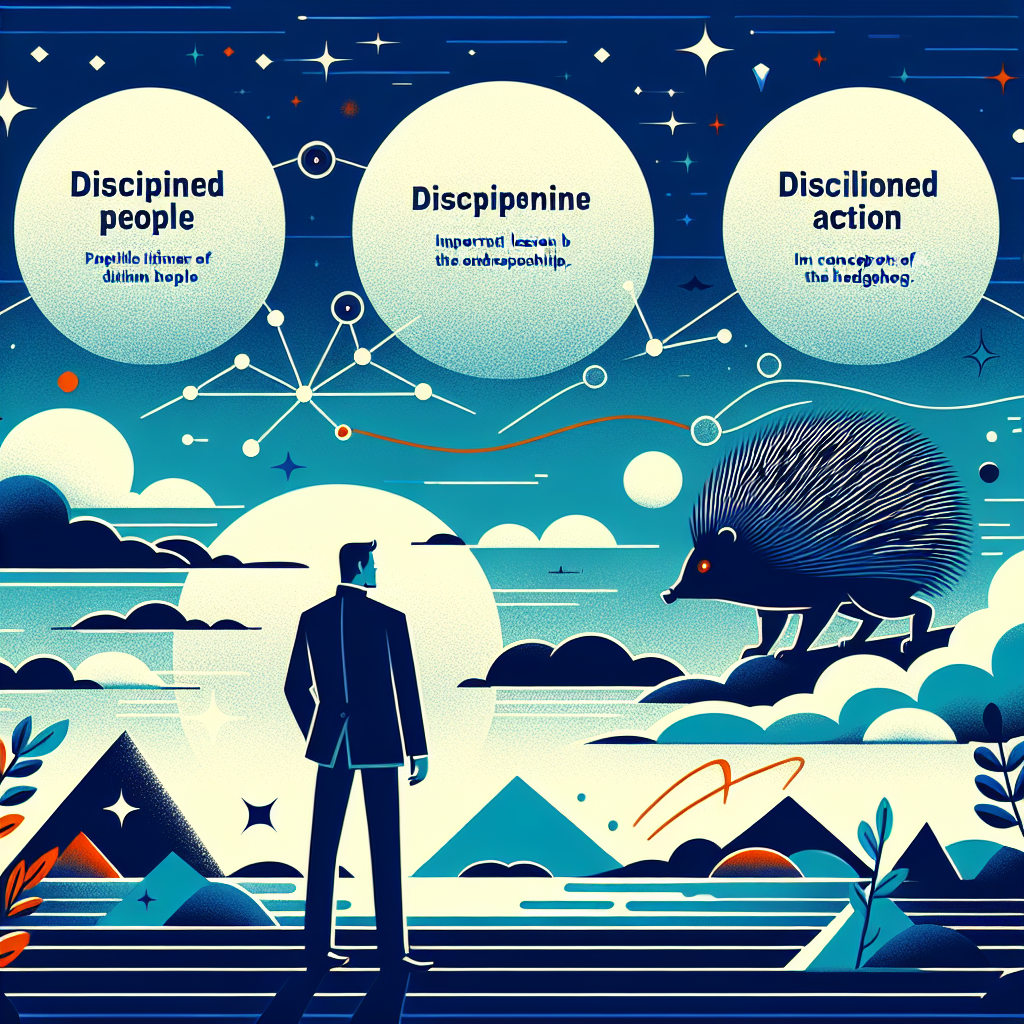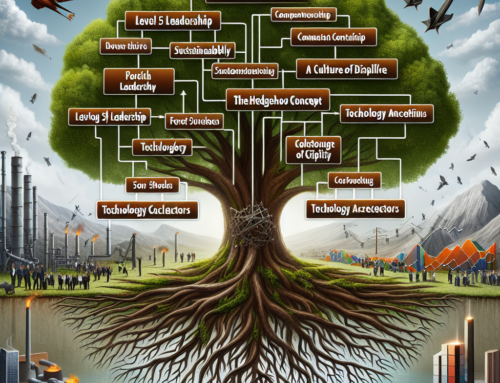
Understanding The Hedgehog Concept
In Jim Collins’ seminal work ”Good to Great,” one of the most compelling concepts introduced is the Hedgehog Concept. This idea, inspired by the ancient Greek parable of the hedgehog and the fox, suggests that while the fox knows many things, the hedgehog knows one big thing. For entrepreneurs, understanding and applying the Hedgehog Concept can be transformative, guiding them toward sustained success and growth.
The Hedgehog Concept is built around three intersecting circles: what you are deeply passionate about, what you can be the best in the world at, and what drives your economic engine. When these three elements align, a business can achieve greatness. To begin with, passion is a critical component. Entrepreneurs often start their ventures driven by a deep-seated enthusiasm for their product or service. This passion is not just about liking what you do; it’s about having a burning desire that fuels perseverance and resilience. When you are passionate about your work, it becomes easier to overcome obstacles and stay committed during tough times.
Transitioning to the second circle, understanding what you can be the best in the world at is equally crucial. This requires a realistic assessment of your strengths and weaknesses. It’s not about being the best in every aspect but identifying a niche where your business can excel. For instance, a tech startup might not be able to compete with giants like Google or Apple in every area, but it could dominate a specific segment of the market with a unique innovation. This focus allows for the development of specialized expertise and a reputation for excellence in that particular domain.
Moving on to the third circle, the economic engine, it’s essential to identify what drives your business’s profitability. This involves understanding your revenue model and the key metrics that impact your financial performance. For some businesses, it might be the number of customers, while for others, it could be the average transaction size or recurring revenue. By pinpointing the primary economic driver, entrepreneurs can make informed decisions that enhance their financial health and sustainability.
The intersection of these three circles is where the magic happens. When a business operates at this sweet spot, it not only survives but thrives. This alignment ensures that the company is doing what it loves, what it’s best at, and what makes money. It creates a sense of purpose and direction, making it easier to set goals and measure progress.
Moreover, the Hedgehog Concept encourages simplicity and focus. In a world where businesses are often tempted to diversify and chase multiple opportunities, this concept serves as a reminder to concentrate on what truly matters. By sticking to their core competencies and passions, entrepreneurs can avoid the pitfalls of overextension and dilution of their brand.
In conclusion, the lessons from Jim Collins’ Hedgehog Concept are invaluable for entrepreneurs. By finding the intersection of passion, excellence, and economic viability, businesses can chart a path to greatness. This concept not only provides a strategic framework but also instills a sense of clarity and purpose. For entrepreneurs looking to elevate their ventures from good to great, embracing the Hedgehog Concept is a step in the right direction.
The Importance Of Level 5 Leadership
In the realm of business literature, few books have had as profound an impact as Jim Collins’ ”Good to Great.” One of the most compelling concepts introduced in this seminal work is the idea of Level 5 Leadership. For entrepreneurs striving to elevate their ventures from good to great, understanding and embodying Level 5 Leadership can be transformative. This concept is not just about achieving success but about sustaining it over the long term.
Level 5 Leadership is characterized by a unique blend of personal humility and professional will. This duality is essential for entrepreneurs who often find themselves at the helm of their organizations, steering them through both calm and turbulent waters. Personal humility involves recognizing that success is not solely the result of one’s efforts but also the contributions of the team and external factors. This humility fosters a culture of collaboration and respect, which is crucial for any organization aiming for greatness.
On the other hand, professional will is the unwavering determination to do whatever it takes to make the company successful. This means setting high standards, making tough decisions, and staying focused on long-term goals. For entrepreneurs, this can often mean the difference between a fleeting success and a lasting legacy. By balancing these two attributes, Level 5 Leaders create an environment where excellence becomes the norm rather than the exception.
Moreover, Level 5 Leaders are known for their ability to build enduring greatness through a paradoxical blend of personal humility and professional will. They are not driven by ego or personal gain but by a deep sense of purpose and commitment to the organization’s success. This is particularly relevant for entrepreneurs who are often the face of their companies. By focusing on the greater good rather than personal accolades, they can inspire their teams to achieve extraordinary results.
Transitioning from good to great also requires a relentless focus on the right people. Level 5 Leaders understand that having the right team in place is more important than having the right strategy. This means hiring individuals who are not only skilled but also aligned with the company’s core values and vision. For entrepreneurs, this can be a game-changer. A cohesive team that shares a common purpose can navigate challenges more effectively and seize opportunities more readily.
Furthermore, Level 5 Leaders are adept at confronting the brutal facts while maintaining unwavering faith in the end goal. This duality is crucial for entrepreneurs who often face uncertain and rapidly changing environments. By acknowledging the reality of their situation, they can make informed decisions and pivot when necessary. At the same time, their steadfast belief in the company’s mission keeps the team motivated and focused on the long-term vision.
Another critical lesson from Level 5 Leadership is the importance of disciplined thought and action. Entrepreneurs are often brimming with ideas and enthusiasm, but without discipline, these can lead to scattered efforts and suboptimal results. Level 5 Leaders channel their energy and resources into a few key priorities, ensuring that every action taken is aligned with the overarching goals. This disciplined approach not only drives progress but also fosters a culture of accountability and excellence.
In conclusion, the concept of Level 5 Leadership from Jim Collins’ ”Good to Great” offers invaluable lessons for entrepreneurs. By embodying personal humility and professional will, focusing on the right people, confronting brutal facts, and maintaining disciplined thought and action, entrepreneurs can transform their ventures from good to great. These principles are not just theoretical but practical guidelines that can lead to sustained success and enduring greatness.
Building A Culture Of Discipline
In the world of entrepreneurship, the quest for success often leads to the exploration of various strategies and methodologies. One of the most influential books in this regard is Jim Collins’ ”Good to Great,” which offers profound insights into what differentiates merely good companies from truly great ones. Among the many lessons Collins imparts, the importance of building a culture of discipline stands out as particularly crucial for entrepreneurs. This concept, while seemingly straightforward, encompasses a range of practices and mindsets that can transform a fledgling startup into a thriving enterprise.
To begin with, a culture of discipline is not about strict adherence to rules or micromanagement. Rather, it is about fostering an environment where disciplined thought and disciplined action are the norms. This starts with hiring the right people—those who are self-motivated and aligned with the company’s core values. When you have a team that is intrinsically driven, the need for external enforcement diminishes. These individuals are more likely to take ownership of their roles, contributing to a collective sense of responsibility and accountability.
Moreover, disciplined people naturally lead to disciplined thought. In this context, disciplined thought involves a rigorous approach to decision-making. Entrepreneurs must encourage their teams to confront the brutal facts of their current reality, no matter how uncomfortable. This honesty allows for more accurate assessments and better strategic planning. For instance, if a particular product is not performing well, acknowledging this fact early on can save valuable resources and redirect efforts towards more promising opportunities.
Transitioning from disciplined thought to disciplined action is the next critical step. This means that once a decision is made, it is executed with unwavering focus and consistency. Entrepreneurs often face the temptation to chase after every new opportunity, but a culture of discipline helps in maintaining a clear focus on the company’s long-term goals. This is where the concept of the ”Hedgehog Principle” from Collins’ book becomes relevant. It suggests that companies should focus on what they can be the best at, what drives their economic engine, and what they are deeply passionate about. By concentrating on these intersecting areas, entrepreneurs can ensure that their actions are aligned with their overarching vision.
Furthermore, a culture of discipline also extends to financial management. Entrepreneurs must be prudent in their spending, ensuring that every dollar is invested wisely. This does not mean being frugal to the point of stifling growth, but rather making informed decisions that balance short-term needs with long-term objectives. For example, investing in quality talent or essential technology can yield significant returns, even if it requires an initial outlay of capital.
In addition, maintaining a disciplined approach to innovation is equally important. While innovation is the lifeblood of any entrepreneurial venture, it should not be pursued haphazardly. A disciplined culture encourages systematic experimentation, where new ideas are tested rigorously before being scaled. This reduces the risk of costly failures and ensures that only the most viable innovations are pursued.
In conclusion, building a culture of discipline is a multifaceted endeavor that requires a combination of the right people, rigorous thinking, focused action, prudent financial management, and systematic innovation. By internalizing these principles from Jim Collins’ ”Good to Great,” entrepreneurs can create a robust foundation for their ventures, enabling them to navigate the complexities of the business world with greater confidence and resilience. Ultimately, this disciplined approach not only drives performance but also fosters a sustainable path to greatness.
The Flywheel And The Doom Loop
In Jim Collins’ seminal work ”Good to Great,” one of the most compelling concepts he introduces is the idea of the Flywheel and the Doom Loop. For entrepreneurs, understanding these concepts can be transformative, offering a roadmap for sustainable success and a cautionary tale of potential pitfalls. The Flywheel represents the cumulative effect of small, consistent efforts that build momentum over time, while the Doom Loop illustrates the destructive cycle of erratic, short-term thinking.
To begin with, the Flywheel concept is all about gradual, steady progress. Imagine a massive, heavy flywheel. At first, pushing it requires immense effort, and the wheel barely moves. However, with persistent effort, the wheel starts to turn faster and faster. Each push builds on the previous one, and eventually, the flywheel gains unstoppable momentum. For entrepreneurs, this means that success is not about one grand, sweeping action but rather a series of small, deliberate steps. By focusing on consistent, incremental improvements, businesses can build a solid foundation that propels them forward.
Moreover, the Flywheel concept emphasizes the importance of patience and perseverance. In the early stages of a business, it can be tempting to look for quick wins or shortcuts. However, these often lead to unsustainable growth and can derail long-term success. Instead, entrepreneurs should focus on building a strong core, refining their processes, and delivering consistent value to their customers. Over time, these efforts will compound, creating a powerful momentum that drives the business forward.
In contrast, the Doom Loop represents the opposite approach. It is characterized by a lack of consistent direction, frequent changes in strategy, and a focus on short-term gains at the expense of long-term stability. Businesses caught in the Doom Loop often react impulsively to market changes, chasing after the latest trends without a clear vision or strategy. This erratic behavior can lead to a cycle of failure, as each new initiative fails to gain traction and the business is left scrambling to find the next big thing.
For entrepreneurs, avoiding the Doom Loop requires a clear vision and a commitment to long-term goals. It is essential to stay focused on the core mission and values of the business, even when faced with external pressures or setbacks. By maintaining a steady course and resisting the urge to make drastic changes, businesses can avoid the destructive cycle of the Doom Loop and build a sustainable path to success.
Furthermore, the Flywheel and the Doom Loop concepts highlight the importance of leadership in driving business success. Effective leaders understand the value of consistency and are able to inspire their teams to stay focused on long-term goals. They create an environment where small wins are celebrated, and incremental progress is valued. On the other hand, leaders who fall into the Doom Loop often create a culture of uncertainty and instability, which can demoralize employees and undermine the business’s overall performance.
In conclusion, the lessons from Jim Collins’ ”Good to Great” offer valuable insights for entrepreneurs. By embracing the Flywheel concept and avoiding the pitfalls of the Doom Loop, businesses can build a strong foundation for sustainable success. It requires patience, perseverance, and a clear vision, but the rewards are well worth the effort. As entrepreneurs navigate the challenges of building and growing their businesses, these principles can serve as a guiding light, helping them to stay focused on their long-term goals and achieve greatness.
First Who, Then What: Getting The Right People On The Bus
In the realm of business literature, few books have had as profound an impact as Jim Collins’ ”Good to Great.” One of the most compelling lessons from this seminal work is encapsulated in the principle of ”First Who, Then What: Getting The Right People On The Bus.” For entrepreneurs, this concept is not just a strategic guideline but a foundational philosophy that can determine the trajectory of their ventures.
At the heart of this principle is the idea that the success of any organization hinges more on the people involved than on the specific direction or strategy it pursues. Collins argues that before deciding where to drive the bus, leaders must first ensure they have the right people on board. This means prioritizing the recruitment and retention of individuals who not only possess the necessary skills but also align with the company’s core values and culture. By doing so, entrepreneurs can create a resilient and adaptable team capable of navigating the uncertainties and challenges inherent in any business journey.
Transitioning from theory to practice, entrepreneurs must recognize that identifying the right people involves more than just evaluating resumes and conducting interviews. It requires a deep understanding of what makes a person a good fit for the organization. This often involves looking beyond technical competencies to assess qualities such as integrity, passion, and the ability to work collaboratively. Entrepreneurs should seek individuals who are not only talented but also share a commitment to the company’s mission and vision.
Once the right people are on the bus, the next step is to ensure they are in the right seats. This means aligning each team member’s strengths and interests with their roles and responsibilities. By doing so, entrepreneurs can maximize productivity and job satisfaction, leading to a more motivated and engaged workforce. It also fosters a culture of accountability, where each person understands their contribution to the overall success of the organization.
Moreover, having the right people on the bus creates a foundation for effective decision-making. When surrounded by capable and aligned individuals, entrepreneurs can confidently delegate responsibilities and trust their team to make informed choices. This not only frees up the leader to focus on strategic initiatives but also empowers employees to take ownership of their work, fostering a sense of autonomy and innovation.
In addition to internal benefits, the principle of ”First Who, Then What” also has significant implications for external relationships. A team composed of the right people is better equipped to build strong partnerships with clients, suppliers, and other stakeholders. Their shared commitment to excellence and ethical conduct enhances the company’s reputation and fosters long-term loyalty and trust.
As entrepreneurs reflect on the lessons from ”Good to Great,” it becomes clear that getting the right people on the bus is not a one-time task but an ongoing process. It requires continuous effort to attract, develop, and retain top talent. This involves creating an environment where people feel valued, challenged, and supported in their professional growth. By investing in their team, entrepreneurs can build a sustainable competitive advantage that propels their business from good to great.
In conclusion, Jim Collins’ principle of ”First Who, Then What” offers invaluable insights for entrepreneurs striving to build successful and enduring companies. By prioritizing the recruitment and alignment of the right people, leaders can create a strong foundation for their business, enabling it to thrive in an ever-changing landscape. As entrepreneurs embark on their journey, they would do well to remember that the road to greatness begins with getting the right people on the bus.
We have lots of exciting coming events in Entrepreneurship, Investing and Personal Development. You can find them all here:
www.swedishwealthinstitute.se/events




